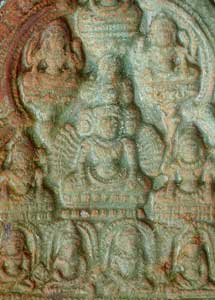Khmer Mold Depicting Hevajra, 12th Century CE - 13th Century CE
Bronze
4.25
FZ.428a
The Bayon style of Khmer art flourished under the rule of a wise and powerful monarch, Jayavarman VII. The sculpture became more lifelike, reflecting more of a human ideal of...
The Bayon style of Khmer art flourished under the rule of a wise and powerful monarch, Jayavarman VII. The sculpture became more lifelike, reflecting more of a human ideal of beauty than the monumental art of the previous Brahmanic periods. Bayon works combined a tempered realism with an intense expressiveness. The famous “Angkor smile" dates to this period. The Bayon period was characterized by its allegiance to the Sakyamuni, a temporary religious trend that would only last until the resurgence of Brahmanic sects shortly after the passing of Jayavarman VII.
The deity Hevajra is the chief deity of the Tantric Buddhist path to enlightenment. Unlike the two other major schools of Buddhism – Theravada and Mahayana – the Tantric school believed that, with serious application and the guidance of a religious teacher, an initiate could achieve enlightenment in this life. Multi-headed, with sixteen arms, Hevajra in fact is the personification of enlightenment here and now; a focal figure in the practice of meditative immersion. This mold, shaped like a lotus blossom, would have been used to make clay idols for personal use by the middle class. The imagery depicts Hevajra at the center surrounded by a ring of nine smaller seated figures. Buddha meditating upon Naga is recognizable directly above Hevajra. The other figures probably represent Bodhisattvas or yogini. The image of Hevajra had begun to appear in Tibet around the 10th century, and there is no evidence of a cult in Southeast Asia before the 12th century, thus dating this piece as an important early example of the cult While the reasons for the popularity of the Hevajra cult in Cambodia are still unclear, it has left the world a magnificent legacy of images such as this, quite distinctive and different from Tibetan Tantric prototypes.
The deity Hevajra is the chief deity of the Tantric Buddhist path to enlightenment. Unlike the two other major schools of Buddhism – Theravada and Mahayana – the Tantric school believed that, with serious application and the guidance of a religious teacher, an initiate could achieve enlightenment in this life. Multi-headed, with sixteen arms, Hevajra in fact is the personification of enlightenment here and now; a focal figure in the practice of meditative immersion. This mold, shaped like a lotus blossom, would have been used to make clay idols for personal use by the middle class. The imagery depicts Hevajra at the center surrounded by a ring of nine smaller seated figures. Buddha meditating upon Naga is recognizable directly above Hevajra. The other figures probably represent Bodhisattvas or yogini. The image of Hevajra had begun to appear in Tibet around the 10th century, and there is no evidence of a cult in Southeast Asia before the 12th century, thus dating this piece as an important early example of the cult While the reasons for the popularity of the Hevajra cult in Cambodia are still unclear, it has left the world a magnificent legacy of images such as this, quite distinctive and different from Tibetan Tantric prototypes.
